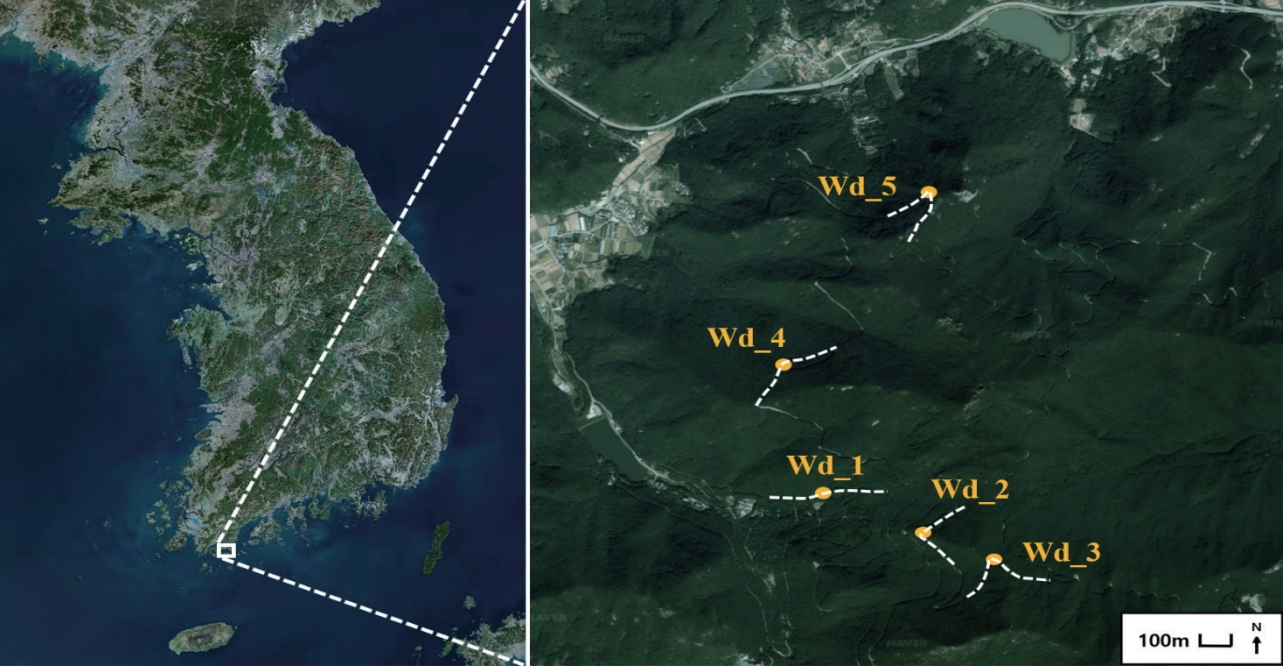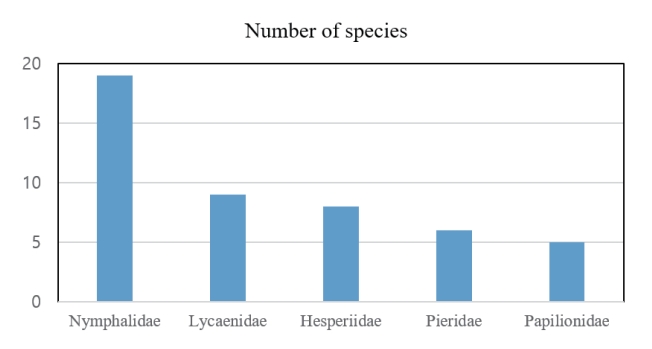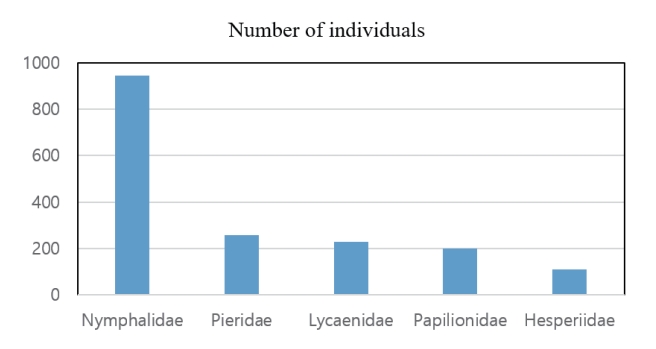Articles
- Page Path
- HOME > GEO DATA > Volume 5(2); 2023 > Article
-
Original Paper
완도 붉가시나무림 5년간(2017-2021년)의 나비 다양성에 대한 정량적 연구 -
이상훈1,†,*
 , 안나현2,†
, 안나현2,†
- Quantitative Study of Butterfly Diversity in Wando Quercus acuta Forest Over 5 Years (2017-2021)
-
Sanghun Lee1,†,*
 , Na-Hyun Ahn2,†
, Na-Hyun Ahn2,†
-
GEO DATA 2023;5(2):55-59.
DOI: https://doi.org/10.22761/GD.2023.0010
Published online: June 20, 2023
1팀장, 국립생태원, 충청남도 서천군 마서면 금강로 1210, 33657, 대한민국
2연구원, 국립생태원, 충청남도 서천군 마서면 금강로 1210, 33657, 대한민국
1Team leader, National Institute of Ecology, 1210 Geumgang-ro, Maseo-myeon, Seocheon-gun, 33657 Chungcheongnam-do, South Korea
2Researcher, National Institute of Ecology, 1210 Geumgang-ro, Maseo-myeon, Seocheon-gun, 33657 Chungcheongnam-do, South Korea
- Corresponding Author Sanghun Lee Tel: +82-41-950-5621 E-mail: sanghunlee@nie.re.kr
- †These authors contributed equally to this work.
Copyright © 2023 GeoAI Data Society
This is an Open Access article distributed under the terms of the Creative Commons Attribution Non-Commercial License (http://creativecommons.org/licenses/by-nc/3.0/) which permits unrestricted non-commercial use, distribution, and reproduction in any medium, provided the original work is properly cited.
- 2,312 Views
- 374 Download
Abstract
- This study presents the long-term quantitative data on butterflies in Wando Arboretum, which represents the only warm-temperate forest located in the southernmost part of South Korea. This arboretum has significant academic value as approximately 770 species of rare woody plants or herbs, such as the Japanese evergreen oak (Quercus acuta), found in warm temperate zones grow under natural conditions here. In this project, the butterflies in this region were studied due to their sensitivity to temperature changes. The study was conducted from March-April to October-November over 5 years (2017-2021) in the region dominated by Japanese evergreen oak. We found 1,743 individuals of 47 butterfly species belonging to five families. The acquired butterfly data could serve as a reference for the further development of a network-oriented database for assessing temporal climate changes.
- 기후 변화는 전 세계적으로 발생하고 있으며 현재도 진행되고 있다. 지난 100년간 우리나라는 평균 기온이 약 1.5℃ 상승하였고, 이는 약 0.6℃ 상승한 전 세계 평균 기온보다 빠른 기후 변화를 의미한다. 지구온난화로 인한 기후 변화가 현재의 추세대로 계속된다면 21세기 후반에는 20세기에 비해 평균 기온은 4.6℃ 상승하고 강수량이 30% 증가할 것으로 예측되며, 극한 강수는 훨씬 더 심해질 것으로 예상된다(Lee and Bae, 2012; Lee et al., 2013). 전 세계에서 발생하는 기온 상승 및 강수량 증가 등의 기후 변화는 종수와 개체수가 풍부하며 넓은 서식지에서 생활하는 곤충에도 많은 영향을 미치고 있다. 이러한 기후 변화는 곤충 군집의 비행 기간 출현 시기의 변화, 세대수의 증가, 극한 강수량에 의한 피해 등 많은 영향을 미치고 있다(Altermatt, 2010; Ellwood et al., 2012; McDermott Long et al., 2016; Sparks et al., 2006; Zografou et al., 2020).
- 나비목은 전 지구적으로 약 160,000종이 있는 것으로 알려져 있으며, 나비목(Lepidoptera)은 곤충강(Insecta)에 속하는 여러 목 가운데 두 번째로 종수가 많고 다양성이 높아 지표종으로 이용되기도 한다. 나비목 곤충은 대부분 일차소비자로 먹이식물과 밀접하게 관련되어 있다. 또한 꿀벌과 함께 수분을 매개하는 중요한 생태지표이기도 하다. 따라서 나비는 식물의 성장에 중요한 역할을 담당하고 있다(Scoble, 1992). 나비는 날개가 크고 무늬가 뚜렷하고 화려해 전문가뿐만 아니라 일반인에게 많은 관심을 받는 곤충이다. 또한 나비는 서식지 변화, 기후 변화와 같은 환경 변화를 감지하는 지표종으로 이용되고 있다(Erhardt, 1985; Fox et al., 2001; Roy et al., 2001; Thomas, 2005). 나비 개체군 변동에 대한 관심으로 인해 영국, 네덜란드, 필란드 등 유럽 여러 나라에서는 전국 수준의 모니터링을 실시 중이며 다양한 형대의 보고서 논문을 출판하고 있다(Asher et al., 2001; van Swaay et al., 2008). 나비는 변온동물로 주변 기온분포와 밀접한 관련이 있어, 최근 기후 변화에 따른 나비의 분포 변동을 추적하여 기후 변화를 감시하는 데 사용하기도 한다(Parmesan et al., 1999). 국내에서도 북방계종의 감소와 남방계 종의 증가를 확인한 연구(Kwon et al., 2010)가 있지만 아직 초기 단계로 나비에 대한 장기적 모니터링은 부족하다.
- 본 연구에서는 5년(2017-2021년) 동안 한국의 국토 최남단에 위치한 완도수목원 내의 5개 지역에서 나비군집의 다양성과 변화를 조사하였다. 완도수목원은 내륙과 연결된 최남단에 위치하고 있어 기후 변화로 인한 남쪽 지역으로부터의 유입을 관찰하기에 유리한 지역이며 기후 변화가 생물군집에 미치는 영향에 대한 이해를 높일 수 있는 잠재력을 가지고 있다. 따라서 본 연구는 현장조사를 바탕으로 종의 다양성과 분포가 기후 변화에 대한 반응을 평가하기 위한 네트워크 지향적 데이터베이스 개발의 기준이 될 것이다.
1. 서론
- 완도수목원은 약 2,033 ha로서 자생생물 770여 종을 보유하고 있으며, 난대림에는 붉가시나무, 구실잣밤나무, 황칠나무, 동백나무 등 상록활엽수가 주를 이루고 있다. 특히 붉가시나무는 완도수목원 전체 수종 가운데 60%를 차지하고 있다. 붉가시나무는 한국과 일본에서 자생하는 종으로(Lee and Choi, 2010; Ohashi et al., 2006), 한반도에는 전라남도 해안지역과 제주도에 분포한다(Choi, 2001). 수목원 중앙에 위치한 상황봉은 해발 644 m이며 정상에 가까운 지역에만 낙엽활엽수가 있고 나머지 지역은 대부분 상록활엽수로 이루어져있다. 완도지역의 평균 기온은 약 14.3℃이며, 강수량은 약 1,531.5 mm로 한반도 내에서는 상대적으로 따뜻한 곳이다(Ahn et al., 2021).
- 나비조사는 Fig. 1에서 표시된 5개 지역을 일정한 속도의 도보로 이동하면서 좌우 5 m 이내에서 관찰되는 나비의 종 및 개체수를 파악하는 선조사법(Pollard and Yates, 1994)을 이용하였다. 각 사이트는 붉가시나무 군락으로 이루어진 지역의 임도를 중심으로 이루어졌으며, 각 사이트는 약 500 m로 하였다. 사이트 선정은 붉가시나무 군락을 기준으로 난대림의 나비분포의 특징을 파악하기 위하여 5개 지역으로 구분하였다. 조사는 2인 1조로 구성하여 오후 1시에서 4시 경에 육안 동정과 포충망을 이용하였으며, 종 동정은 한반도 나비도감(Paek and Shin, 2014)을 이용하였다. 샘플링 편향을 최소화하기 위하여 5개의 사이트를 같은 날에 진행하였다. 각 조사지역의 고도, 위경도 등은 Table 1과 같다.
2. 조사지역 개요 및 조사 방법
- 조사 결과 완도수목원 붉가시나무군락의 나비는 총 5과, 47종, 총 1,743개체수가 출현하였으며, 네발나비과 (Nymphalidae)는 종수는 19종(전체 종수 40%), 개체수는 946개체(전체 개체수 중 54%)로 전체의 약 절반 정도를 차지하고 있었다. 나머지 네 과는 종수는 10종 이내, 개체수는 약 200개체 정도로 적게 나타났다(Figs. 2, 3).
3. 결과
- 본 조사는 우리나라 내륙과 연결된 국토 최남단에 위치한 완도수목원 붉가시나무군락에서 나비의 다양성과 분포를 알아보기 위하여 5년간 진행하였으며, 기후 변화로 인한 남쪽으로부터의 유입을 파악하는 데 중요한 역할을 할 것으로 판단된다. 또한 향후 지속적으로 조사를 진행한다면 미래 기후 변화로 인한 예측과 영향을 파악하는 데 많은 도움이 될 것이다.
4. 결론 및 토의
-
Conflict of Interest
Sanghun Lee has been an Editorial Board of GEO DATA; however, he was not involved in the peer reviewer selection, evaluation, or decision process of this paper. Otherwise, no other potential conflicts of interest relevant to this paper were reported.
-
Funding Information
This study was supported by the Ministry of the Environment, Republic of Korea (NIE-B-2023-1).
-
Data Availability Statement
The data that support the findings of this study are openly available in [EcoBank] at http://doi.or.kr/10.22756/GEO.20220000000807.
Notes
- Ahn NH, Lee SH, Choi SW (2021) A study on the biodiversity and seasonal changes of Macromoths inhabiting the warm temperate deciduous forest on Wando-arboretum. The J Kor Isl 33(4):141–164Article
- Altermatt F (2010) Climatic warming increases voltinism in European Butterflies and Moths. Proc Biol Sci 277(1685):1281–1287ArticlePubMedPMCPDF
- Asher J, Warren M, Fox R, Harding P, Jeffcoate G, Jeffcoate S (2001) The millennium atlas of butterflies in Britain and Ireland. Oxford, Oxford University Press, p. 433
- Choi TB (2001) Genetic structure and diversity of three oak species (Quercus, Subgen. Cyclobalanopsis) in Korea and conservation strategy for Q. acuta Thunb. ex murray. Ph.D. Thesis. Seoul National University; 4
- Ellwood ER, Diez JM, Ibáñez I, et al (2012) Disentangling the paradox of insect phenology: are temporal trends reflecting the response to warming? Oecologia 168(4):1161–1171ArticlePubMedPDF
- Erhardt A (1985) Diurnal lepidoptera: sensitive indicators of cultivated and abandoned grassland. J Appl Ecol 22(3):849–861Article
- Fox R, Warren MS, Harding PT, et al (2001) The State of Britain’s Butterflies. Butterfly Conservation. Wareham, CEH and JNCC, p. 18
- Kwon TS, Kim SS, Chun JH, Byun BK, Lim JH, Shin JH (2010) Changes in butterfly abundance in response to global warming and reforestation. Environ Entomol 39(2):337–345ArticlePubMed
- Lee JH, Choi BH (2010) Distribution and northernmost limit on the Korean Peninsula of three evergreen trees. Korean J Pl Taxon 40(4):267–273ArticlePDF
- Lee S, Bae DH (2012) Local effects of climate change over South Korea with a high-resolution climate scenario. Clim Res 54(1):85–93Article
- Lee S, Bae DH, Cho CH (2013) Changes in future precipitation over South Korea using a global high-resolution climate model. Asia Pac J Atmos Sci 49(5):619–624ArticlePDF
- McDermott Long O, Warren R, Price J, Brereton TM, Botham MS, Franco AM (2016) Sensitivity of UK butterflies to local climatic extremes: which life stages are most at risk? J Anim Ecol 86(1):108–116ArticlePubMedPDF
- Ohashi H, Ojashi K, Takahashi H (2006) Identity of Quercus acuta Thunb. (Fagaceae) recorded from Taiwan and China. J Jpn Bot 81(5):268–274
- Paek MK, Shin YH (2014) Guide book of butterflies in Korean peninsula. Nature and Ecosystem Press, Seoul
- Parmesan C, Ryrholm N, Stefanescu C, et al (1999) Poleward shifts in geographical ranges of butterfly species associated with regional warming. Nature 399(6736):579–583ArticlePDF
- Pollard ET, Yates J (1994) Monitoring butterflies for ecology and conservation: the British butterfly monitoring scheme. Springer Sciences & Business Media, London, p. 274
- Roy DB, Rothery P, Moss D, Pollard E, Thomas JA (2001) Butterfly numbers and weather: predicting historical trends in abundance and the future effects of climate change. J Anim Ecol 70(2):201–217ArticlePDF
- Scoble MJ (1992) The Lepidoptera. Form, Function and Diversity. Oxford University Press, Oxford, p. 404
- Sparks TH, Huber K, Dennis RL (2006) Complex phenological responses to climate warming trends? Lessons from history. Eur J Entomol 103(2):379–386Article
- Thomas JA (2005) Monitoring change in the abundance and distribution of insects using butterflies and other indicator groups. Philos Trans R Soc Lond B Biol Sci 360(1454):339–357ArticlePubMedPMCPDF
- van Swaay CA, Nowicki P, Settele J, Van Strien AJ (2008) Butterfly monitoring in Europe: methods, applications and perspectives. Biodivers Conserv 17(14):3455–3469ArticlePDF
- Zografou K, Grill A, Wilson RJ, Halley JM, Adamidis GC, Kati V (2020) Butterfly phenology in Mediterranean mountains using space-for-time substitution. Ecol Evol 10(2):928–939ArticlePubMedPMCPDF
References
Appendix
| Sort | Field | Subcategory#1 | Subcategory#2 |
|---|---|---|---|
| Essential | *Title | Quantitative butterflies data for five years (2017-2021) in Quercus acuta forest in Wando island | |
| *DOI name | http://doi.or.kr/10.22756/GEO.20220000000807 | ||
| *Category | Biota | ||
| Abstract | |||
| *Temporal Coverage | 5 years | From 2017 to 2021 | |
| *Spatial Coverage | Address | ||
| WGS84 coordinates | Line | ||
| Latitude: 34˚21´19˝ N to 34˚22´39˝ N | |||
| Longitude: 126˚40´18˝ E to 126˚41´07˝ E | |||
| *Personnel | Name | Sanghun Lee | |
| Affiliation | National Institute of Ecology | ||
| sanghunlee@nie.re.kr | |||
| *CC License | CC BY-NC | ||
| Optional | *Project | Improvement and maintenance of EcoBank (1st year) | |
| *Instrument | Insect net |
Figure & Data
References
Citations


 GAIDAS
GAIDAS



 PubReader
PubReader ePub Link
ePub Link Cite
Cite




